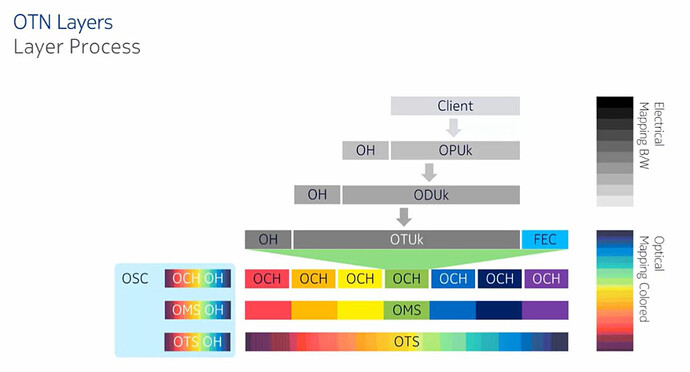Hello All.
I want to introduce the differences between DWDM and OTN.
-
WDM: Wavelength Division Multiplexing
WDM refers to a technology that allows optical signals at multiple wavelengths to transmit over one optical fiber. -
OTN: Optical Transmission Network
Based on WDM, OTN integrates some advantages of SDH such as abundant OAM overheads, flexible service grooming and perfect protection modes.
OTN service grooming is classified into optical-layer grooming and electrical-layer grooming.
- OTN consist of 2 layers:
- Optical Photonic Layer (L0): End to End management and monitor.
- Electrical Digital Layer (L1): Mapping client signals into a uniform format.
- Optical Digital Layer (L0) have 3 Layers:
-
OTS: Optical Transport Section.
- Provide transport function for OMS signal.
- One to one mapping between both layers.
- Define frequency and power level.
- Includes overheads bytes for maintenance ant management.
-
OMS: Optical Multiplexing Section.
- Multiplexing serval optical channels.
- Includes overhead information for signal monitoring.
- Overhead transmitted in OSC.
-
OCH: Optical Channel Unit.
- End to End connectivity.
- Corresponds with OTU of the electro-optical layer.
- OSC is transmitted in separated optical channel.
- Electrical Digital Layer (L1) have 3 layers:
- OTU: Optical Transport Unit
- ODU: Optical Data Unit
- OPU: Optical Payload Unit
- Differences between WDM and OTN
- WDM technology applies only to the optical layer and not apply to the electrical layer. OTN includes both the optical layer and the electrical layer.
- On a traditional WDM network, one wavelength can transmit only one service. One wavelength on an OTN network can transmit multiple services at the same time.
- WDM sites have only OTU boards. In OTN, OTU board is divided into two parts: Client board (ANY rate cards Such as 30AN300) and line board (Uplink cards such as 2UC400) and electrical cross-connect boards are added. OTU boards can also be directly installed on OTN products.
- The powerful overhead and monitoring capabilities supported by OTN improve network self-healing protection and reliability. The WDM technology can provide only optical-layer protection. The OTN technology can provide both optical-layer protection and electrical-layer protection.
- OTN supports more types of services and higher board integration.
- Through electrical-layer cross-connection grooming, OTN can flexibly schedule and allocate channel resources, improving bandwidth resource utilization.
- The WDM technology has no corresponding frame structure, whereas the OTN technology has a complete frame structure.
- OTN sites use a large number of electrical-layer boards. So, network construction costs are high. WDM site doesn’t have a large number of electrical-layer boards. So, network construction cost is low.
LinkedIn: ![]()
